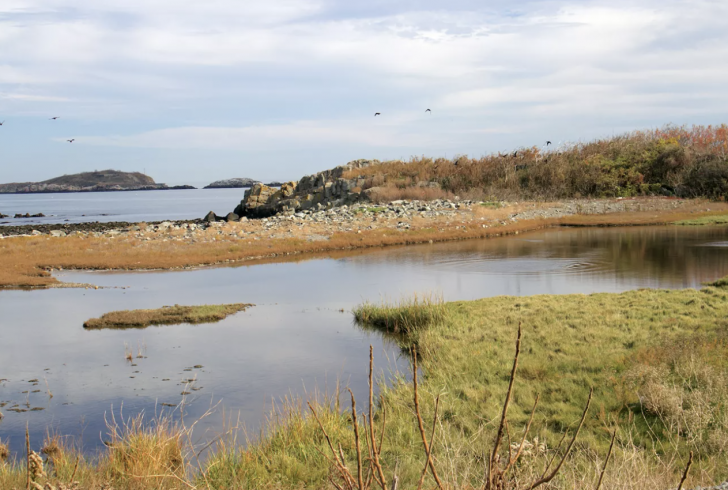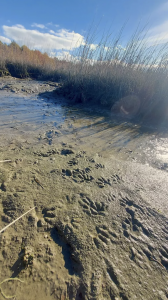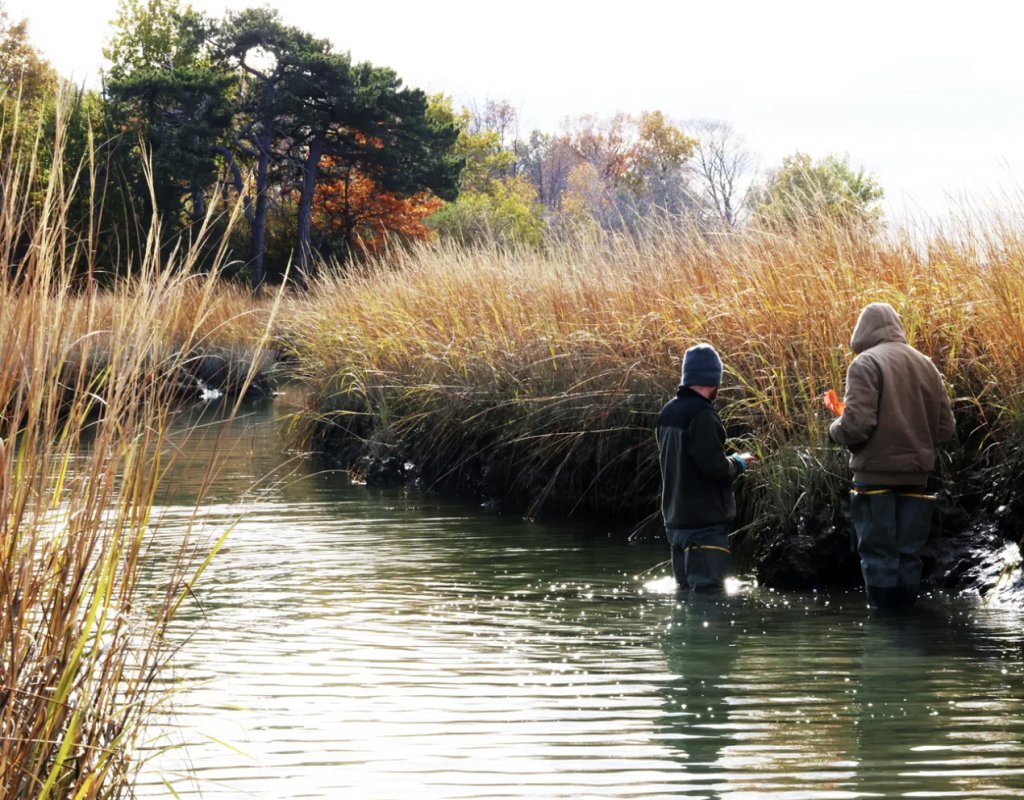Unraveling the Mystery of Marsh Migration on the Boston Harbor Islands


On top of spectacular natural beauty and refreshing tranquility away from the hustle and bustle of city life, the Boston Harbor Islands offer a host of favors to humans and animals alike. There is one special ecosystem sprinkled throughout the islands that particularly epitomizes this prolific generosity: salt marshes.
Uniquely positioned where the ocean meets the shore, salt marshes stir together a beautiful stew of chemical, physical, and biological traits that foster the well-being of even those who live far beyond their boundary line. This ecosystem’s extensive resume includes such talents as carbon sequestration, water quality improvement, coastal flooding protection, refuge for migrating birds, and shelter for endangered species.
However, climate change looms large over these delicate habitats, bombarding them with perils as loud as thrashing storms and as quietly relentless as sea level rise. The National Parks of Boston Climate Conservation Corps (NPB CCC) is working to defend this bountiful ecosystem through science.
Salt marshes of varying shapes and sizes can be found on many of the 34 islands and peninsulas that make up the Boston Harbor Islands. Some of these marshes appear as narrow stretches of Spartina alterniflora, or marsh grass, snaking along an island shore. These are aptly named fringing salt marshes. Others consist of much larger fields of marsh grass encircling wide inlets of ocean water. These are called embayed salt marshes.
By monitoring the shapes and sizes of the salt marshes standing on the harbor islands, the NPB CCC can disentangle the complexities of how this ecosystem fares under climate change. In doing so, the team will establish critical context that will inform the park’s management decisions on how to best aid salt marshes in the coming years as climate change rumbles louder and louder.

Situated along the coastline, salt marshes resemble a mosaic of grassy puzzle pieces entwined in mazelike channels of water. Like lungs taking a breath, these channels rise and fall with each day’s tides.
The conditions in a salt marsh are tough and temperamental; organisms must survive high salt concentrations, frequent switches from total to slight submersion, and to top it all off, soil devoid of oxygen.
But despite all these challenges, salt marshes are full of life. From feathered friends like egrets and black-crowned night herons to scaly swimmers like mummichog to crabs, shellfish, and even small mammals like meadow voles, a myriad of creatures enjoy a charming shoreline life among the grasses and waters of the salt marshes in the Boston Harbor Islands.
Apart from providing shelter to a rich diversity of fauna, salt marshes are also full-time carbon sinks. This means that the amount of carbon stored within the marsh—both within living plant tissue as well as dead plant material buried underground—far outweighs the amount of carbon dioxide breathed out by marsh plants.
Earth’s carbon sinks play a critical role in mitigating the spiraling catastrophes of climate change.
There is a special name for carbon stored within coastal and marine environments—it’s called blue carbon. Although blue carbon sinks often enjoy less fanfare than higher profile carbon-storers like giant sequoias, blue carbon ecosystems are some of the biggest carbon sinks on Earth. In fact, scientists estimate that salt marshes bury 50 times more carbon each year than terrestrial forests, measured in g/m^2 (Mcleod et al., 2011).
As hotspots of blue carbon, salt marsh ecosystems are immensely beneficial to humans when intact. However, that immense carbon storage becomes disastrous when marshes are damaged. Their ample reservoir of carbon barrels straight into the atmosphere, where it becomes a climate change propellant once more.
Preventing salt marshes from getting damaged keeps carbon underground, far from the atmosphere. That’s why salt marsh protection is critical in the fight against climate change. Somewhat ironically, though, climate change is one of the main forces that jeopardize salt marshes, threatening to transform these powerful ecosystems from carbon sinks to carbon sources.

A member of the Climate Conservation Corps stands in a field of Spartina alterniflora in a saltmarsh on Thompson Island.
NPS Photo/ E. Bernbaum
Salt marshes would be completely vulnerable to sea level rise were it not for a feature within their nature that helps them escape to higher ground. This clever response is called marsh migration.
Like migrating animals changing the locations of their homes, salt marshes migrate too—but on a longer, less seasonal timescale.
This phenomenon, which happens in salt marshes all around the world, begins with storms. Storms stir up loose sediment from the eroding areas of watersheds and wash it downstream toward the ocean. Just before reaching the sea, that soil and organic matter gets tangled in marsh grass. Over time, as the sediment settles across the marsh’s surface, it raises the height of the ground itself. Now, the stage is set for plants to relocate—something else that storms facilitate.
Storms inundate non-wetland plants in upland areas with salty water, which, after a certain point, they cannot survive. The process opens up previously crowded upland spaces for other, hardier plants to inhabit. A resident who can survive salty conditions, is of course, marsh grass.
Thanks to increasing surface elevation from settling sediments and slowly expanding real estate for marsh vegetation, marshes spread upland over the course of several generations. So, although storms seem villainous when they flood marsh vegetation, in another light, they act as heroes, setting off the chain of events that allow marshes to escape their doom.
Salt marshes, including the ones on the Boston Harbor Islands, are constantly shifting as they participate in this dance of inundation and migration.
Unfortunately, marsh migration is not a guarantee. When the rate of sea level rise surpasses the rate of marsh migration, salt marshes transform into a much more desolate ecosystem—a mudflat. This is the fate that awaits some of the marshes on the Boston Harbor Islands.
Others, though, will be able to migrate inland. Those are the marshes that the NPB CCC is looking to assist.
The NPB CCC aims to aid the salt marshes of the Boston Harbor Islands by examining their history of movement and determining their future migration potential.
The first phase of this project is to establish an understanding of the existing structure and extent of salt marshes on the islands. To do so, the NPB CCC is mapping the borders of salt marshes on Thompson, Peddocks, Lovells, Calf, Great Brewster, and Grape Islands using GPS. These maps will capture a crucial snapshot of the current extent of island marshes – a snapshot that the NPB CCC can use to paint a picture of marsh migration through time.

Two Climate Conservation Corps members traverse the waters of a salt marsh on Thompson Island to collect GPS data on marsh extent.
NPS Photo / E. Bernbaum
Establishing photo points will also be key to the NPB CCC’s strategy. By taking photos of the same locations over time, the team can witness changes in marsh position by eye. This type of documentation is useful for observing marshes becoming inundated with sea water as well as marshes that are emerging at novel locations.
Photo points will be especially useful following major storm events since the shoreline areas that get swamped during storms will likely be the same areas first flooded by sea level rise. In this way, storms act as a canary in a coal mine, illuminating the areas of the marsh most at risk of drowning in the future.
The NPB CCC has already established 15 photo points across six different islands—Thompson, Peddocks, Lovells, Calf, Great Brewster, and Grape. The photo points are stationed both at existing salt marshes and locations on the islands with the right set of ingredients for future marshes to form. The team plans to take photos at these sites seasonally, which, if continued by future NPB CCC cohorts, would become a valuable illustration of marsh motion over time. As for now, the team’s photo point images will combine with their mapping data to illustrate the current shape and size of Boston Harbor Island salt marshes.
The final step of the team’s project is to compare their snapshot of current marsh position to historic records to figure out how fast, how much, and to what locations the marshes are migrating. To inform their estimations, the team will examine island topography, using elevation data to predict where sea level rise will inundate the islands. The team will use this data to elucidate which marshes are threatened by sea level rise as well as identify the areas on the islands that offer potential for new marshes to form or migrate.
All of this data will allow park managers to consider how to adapt island features, such as trails, in order to foster marsh migration. The data will also help the NPB CCC continue to tell the story of what we stand to gain and lose from sea level rise on the Boston Harbor Islands.
Mcleod, Elizabeth, et al. “A blueprint for Blue Carbon: Toward an improved understanding of the role of vegetated coastal habitats in sequestering co2.” Frontiers in Ecology and the Environment, vol. 9, no. 10, 20 Jan. 2011, pp. 552–560, https://doi.org/10.1890/110004.